TOYOTA PROACE VERSO 2020 User Guide
Manufacturer: TOYOTA, Model Year: 2020, Model line: PROACE VERSO, Model: TOYOTA PROACE VERSO 2020Pages: 418, PDF Size: 39.32 MB
Page 11 of 418
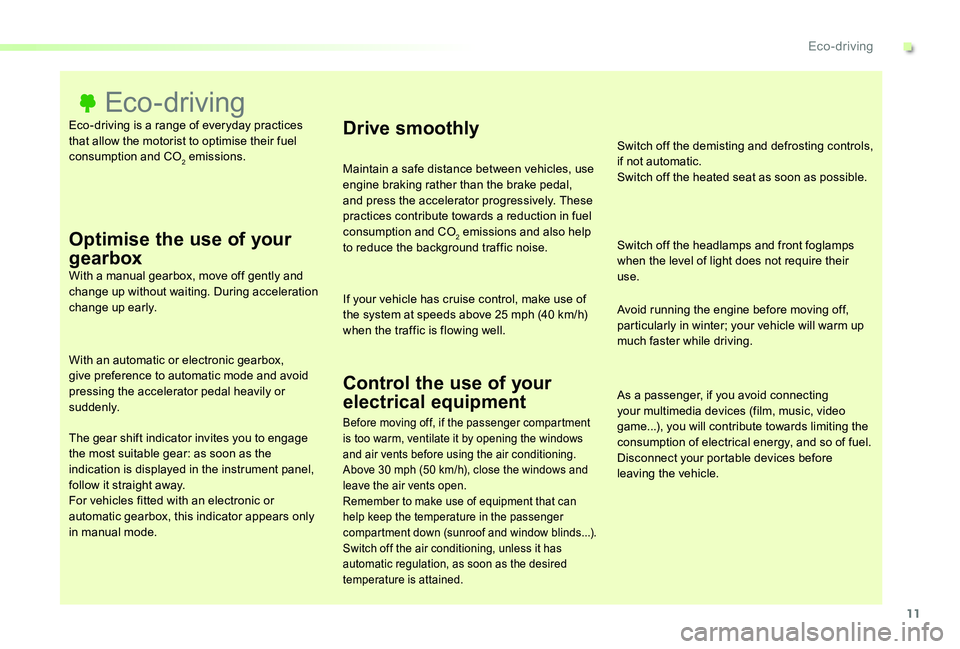
11
Eco-driving is a range of everyday practices that allow the motorist to optimise their fuel consumption and CO2 emissions.
Eco- driving
Optimise the use of your
gearboxWith a manual gearbox, move off gently and change up without waiting. During acceleration change up early.
With an automatic or electronic gearbox, give preference to automatic mode and avoid pressing the accelerator pedal heavily or suddenly.
The gear shift indicator invites you to engage
the most suitable gear: as soon as the indication is displayed in the instrument panel, follow it straight away.For vehicles fitted with an electronic or automatic gearbox, this indicator appears only in manual mode.
Drive smoothly
Maintain a safe distance between vehicles, use engine braking rather than the brake pedal, and press the accelerator progressively. These practices contribute towards a reduction in fuel consumption and CO2 emissions and also help to reduce the background traffic noise.
If your vehicle has cruise control, make use of the system at speeds above 25 mph (40 km/h) when the traffic is flowing well.
Control the use of your
electrical equipment
Switch off the demisting and defrosting controls, if not automatic.Switch off the heated seat as soon as possible.
Switch off the headlamps and front foglamps when the level of light does not require their use.
Avoid running the engine before moving off, particularly in winter; your vehicle will warm up much faster while driving.
As a passenger, if you avoid connecting your multimedia devices (film, music, video game...), you will contribute towards limiting the consumption of electrical energy, and so of fuel.Disconnect your portable devices before leaving the vehicle.
Before moving off, if the passenger compartment is too warm, ventilate it by opening the windows and air vents before using the air conditioning.Above 30 mph (50 km/h), close the windows and leave the air vents open.Remember to make use of equipment that can help keep the temperature in the passenger compartment down (sunroof and window blinds...).Switch off the air conditioning, unless it has automatic regulation, as soon as the desired temperature is attained.
.
Eco-driving
Page 12 of 418
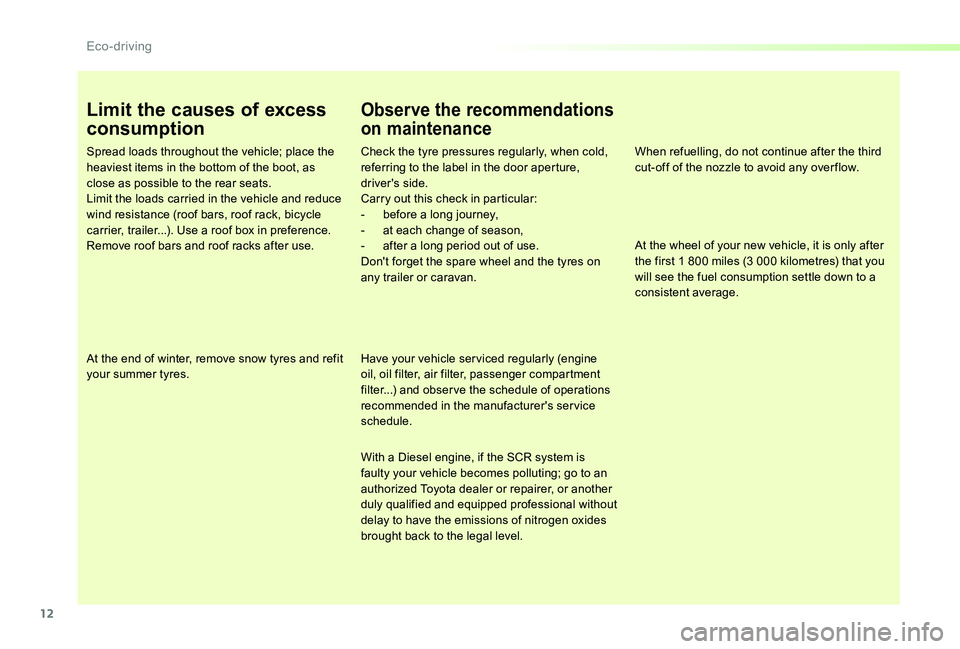
12
Limit the causes of excess
consumption
Spread loads throughout the vehicle; place the heaviest items in the bottom of the boot, as close as possible to the rear seats.Limit the loads carried in the vehicle and reduce wind resistance (roof bars, roof rack, bicycle carrier, trailer...). Use a roof box in preference.Remove roof bars and roof racks after use.
At the end of winter, remove snow tyres and refit your summer tyres.
Observe the recommendations
on maintenance
Check the tyre pressures regularly, when cold, referring to the label in the door aperture, driver's side.Carry out this check in particular:- before a long journey,- at each change of season,
- after a long period out of use.Don't forget the spare wheel and the tyres on any trailer or caravan.
Have your vehicle ser viced regularly (engine oil, oil filter, air filter, passenger compartment filter...) and obser ve the schedule of operations recommended in the manufacturer's service schedule.
With a Diesel engine, if the SCR system is faulty your vehicle becomes polluting; go to an authorized Toyota dealer or repairer, or another duly qualified and equipped professional without delay to have the emissions of nitrogen oxides brought back to the legal level.
When refuelling, do not continue after the third cut-off of the nozzle to avoid any over flow.
At the wheel of your new vehicle, it is only after the first 1 800 miles (3 000 kilometres) that you will see the fuel consumption settle down to a consistent average.
Eco-driving
Page 13 of 418
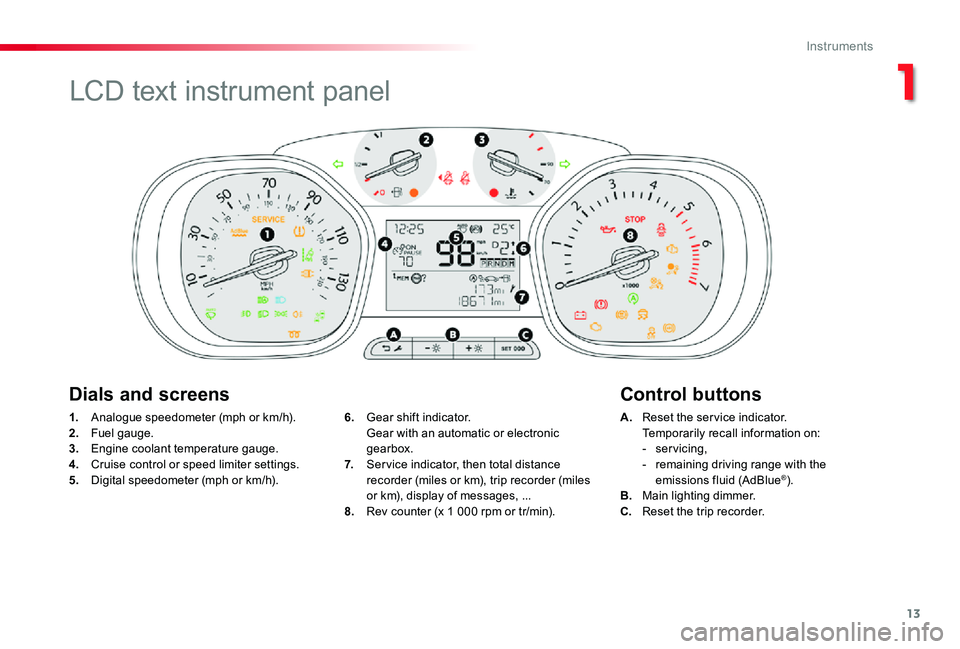
13
1. Analogue speedometer (mph or km/h).2. Fuel gauge.3. Engine coolant temperature gauge.4. Cruise control or speed limiter settings.5. Digital speedometer (mph or km/h).
A. Reset the service indicator. Temporarily recall information on:- servicing,- remaining driving range with the emissions fluid (AdBlue®).B. Main lighting dimmer.C. Reset the trip recorder.
6. Gear shift indicator. Gear with an automatic or electronic gearbox.7. Ser vice indicator, then total distance recorder (miles or km), trip recorder (miles or km), display of messages, ...8. Rev counter (x 1 000 rpm or tr/min).
Dials and screensControl buttons
LCD text instrument panel
1
Instruments
Page 14 of 418
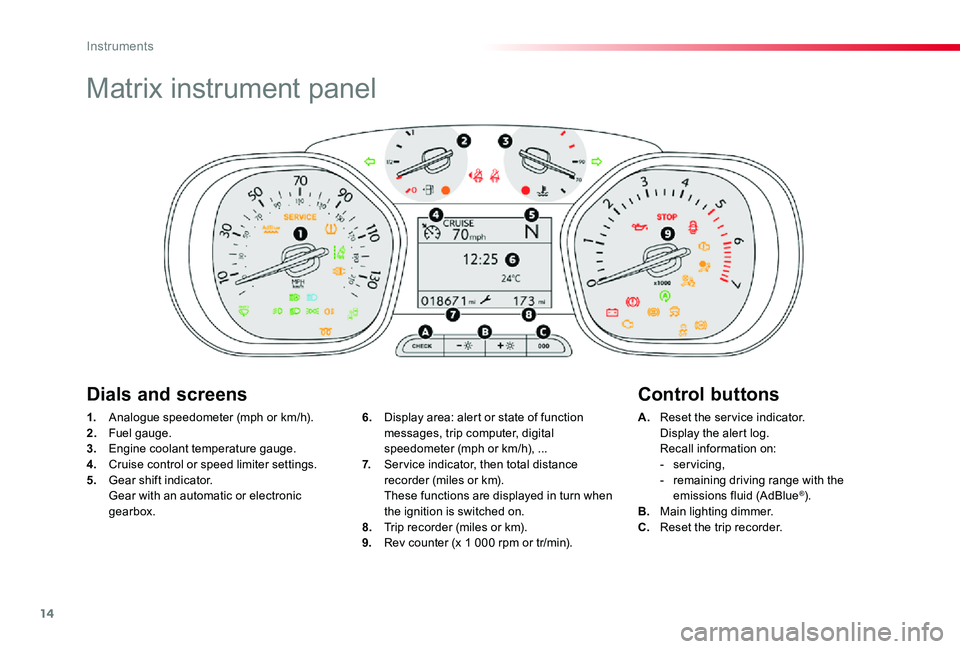
14
Matrix instrument panel
1. Analogue speedometer (mph or km/h).2. Fuel gauge.3. Engine coolant temperature gauge.4. Cruise control or speed limiter settings.5. Gear shift indicator. Gear with an automatic or electronic gearbox.
A. Reset the service indicator. Display the alert log. Recall information on:- servicing,- remaining driving range with the emissions fluid (AdBlue®).B. Main lighting dimmer.C. Reset the trip recorder.
6. Display area: alert or state of function messages, trip computer, digital speedometer (mph or km/h), ...7. Ser vice indicator, then total distance recorder (miles or km). These functions are displayed in turn when the ignition is switched on.8. Trip recorder (miles or km).9. Rev counter (x 1 000 rpm or tr/min).
Dials and screensControl buttons
Instruments
Page 15 of 418
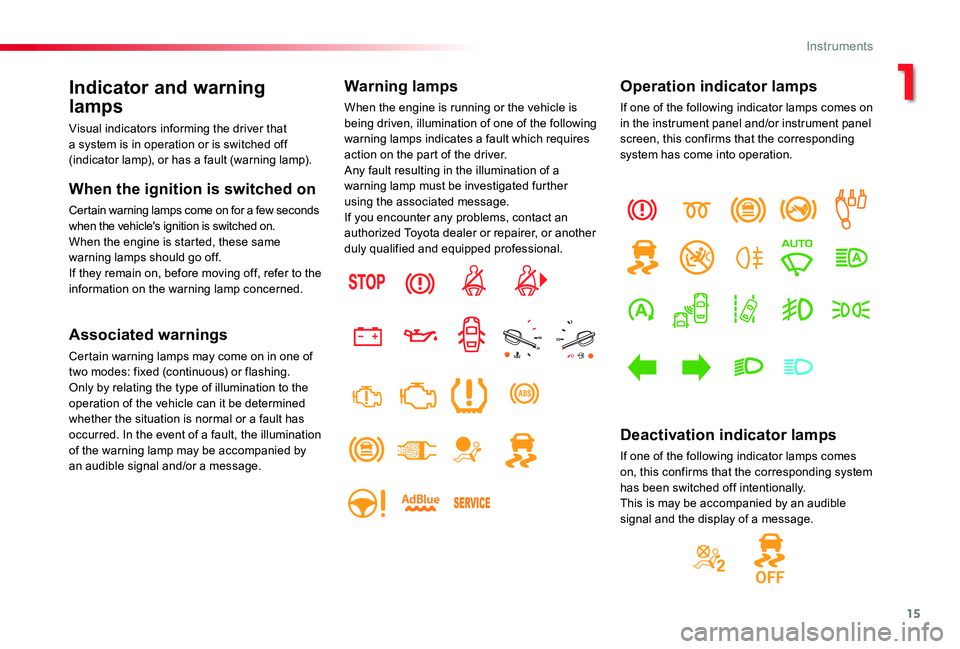
15
Indicator and warning
lamps
Visual indicators informing the driver that a system is in operation or is switched off (indicator lamp), or has a fault (warning lamp).
When the ignition is switched on
Certain warning lamps come on for a few seconds when the vehicle's ignition is switched on.When the engine is started, these same warning lamps should go off.If they remain on, before moving off, refer to the information on the warning lamp concerned.
Associated warnings
Certain warning lamps may come on in one of two modes: fixed (continuous) or flashing.Only by relating the type of illumination to the operation of the vehicle can it be determined whether the situation is normal or a fault has occurred. In the event of a fault, the illumination of the warning lamp may be accompanied by an audible signal and/or a message.
Warning lamps
When the engine is running or the vehicle is being driven, illumination of one of the following warning lamps indicates a fault which requires action on the part of the driver.Any fault resulting in the illumination of a warning lamp must be investigated further using the associated message.If you encounter any problems, contact an authorized Toyota dealer or repairer, or another duly qualified and equipped professional.
Operation indicator lamps
If one of the following indicator lamps comes on in the instrument panel and/or instrument panel screen, this confirms that the corresponding system has come into operation.
Deactivation indicator lamps
If one of the following indicator lamps comes on, this confirms that the corresponding system has been switched off intentionally.This is may be accompanied by an audible signal and the display of a message.
1
Instruments
Page 16 of 418
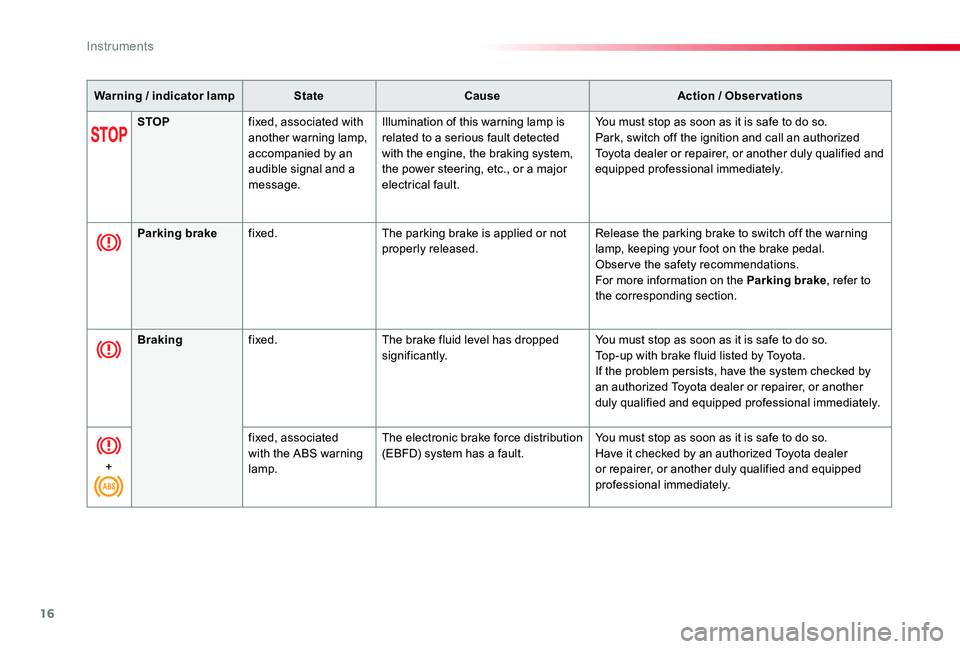
16
Warning / indicator lampStateCauseAction / Observations
STOPfixed, associated with another warning lamp, accompanied by an audible signal and a message.
Illumination of this warning lamp is related to a serious fault detected with the engine, the braking system, the power steering, etc., or a major electrical fault.
You must stop as soon as it is safe to do so.Park, switch off the ignition and call an authorized Toyota dealer or repairer, or another duly qualified and equipped professional immediately.
Parking brakefixed.The parking brake is applied or not
properly released.
Release the parking brake to switch off the warning
lamp, keeping your foot on the brake pedal.Obser ve the safety recommendations.For more information on the Parking brake, refer to the corresponding section.
Brakingfixed.The brake fluid level has dropped significantly.You must stop as soon as it is safe to do so.Top-up with brake fluid listed by Toyota.If the problem persists, have the system checked by an authorized Toyota dealer or repairer, or another duly qualified and equipped professional immediately.
+
fixed, associated with the ABS warning lamp.
The electronic brake force distribution (EBFD) system has a fault.You must stop as soon as it is safe to do so.Have it checked by an authorized Toyota dealer or repairer, or another duly qualified and equipped professional immediately.
Instruments
Page 17 of 418
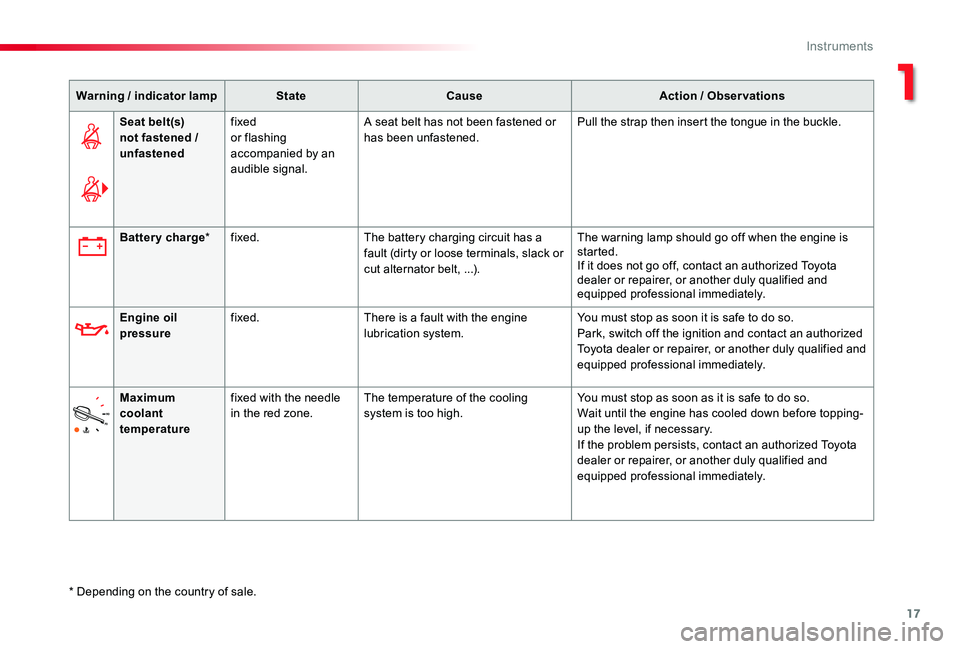
17
Warning / indicator lampStateCauseAction / Observations
Seat belt(s) not fastened / unfastened
fixedor flashing accompanied by an audible signal.
A seat belt has not been fastened or has been unfastened.Pull the strap then insert the tongue in the buckle.
* Depending on the country of sale.
Battery charge*fixed.The battery charging circuit has a
fault (dirty or loose terminals, slack or cut alternator belt, ...).
The warning lamp should go off when the engine is started.If it does not go off, contact an authorized Toyota dealer or repairer, or another duly qualified and equipped professional immediately.
Engine oil pressurefixed.There is a fault with the engine lubrication system.You must stop as soon it is safe to do so.Park, switch off the ignition and contact an authorized Toyota dealer or repairer, or another duly qualified and equipped professional immediately.
Maximum coolant temperature
fixed with the needle in the red zone.The temperature of the cooling system is too high.You must stop as soon as it is safe to do so.Wait until the engine has cooled down before topping-up the level, if necessary.
If the problem persists, contact an authorized Toyota dealer or repairer, or another duly qualified and equipped professional immediately.
1
Instruments
Page 18 of 418
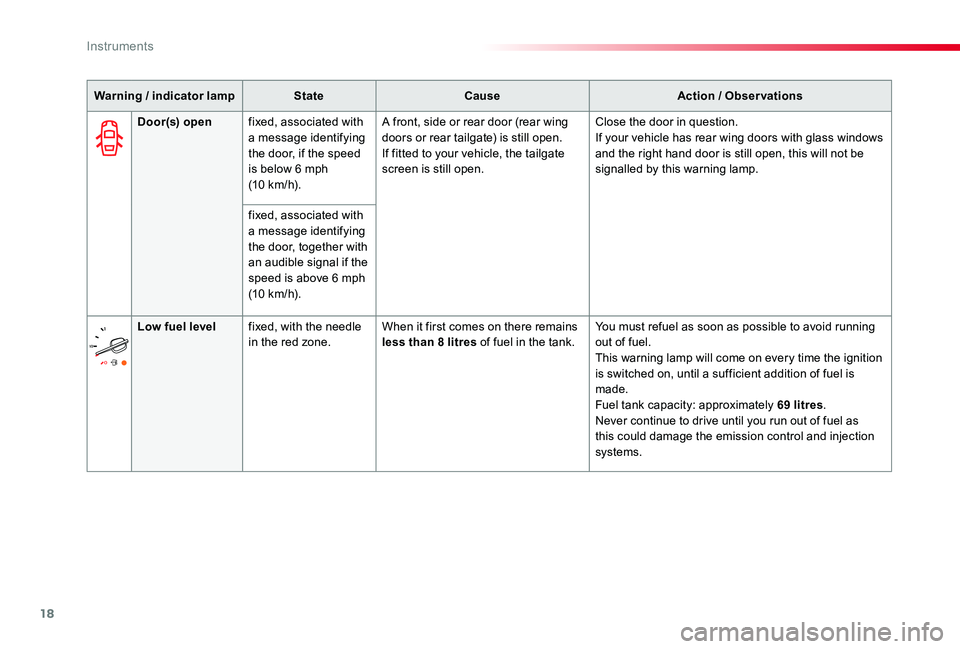
18
Warning / indicator lampStateCauseAction / Observations
Door(s) openfixed, associated with a message identifying the door, if the speed is below 6 mph (10 km/h).
A front, side or rear door (rear wing doors or rear tailgate) is still open.If fitted to your vehicle, the tailgate screen is still open.
Close the door in question.If your vehicle has rear wing doors with glass windows and the right hand door is still open, this will not be signalled by this warning lamp.
fixed, associated with a message identifying
the door, together with an audible signal if the speed is above 6 mph (10 km/h).
Low fuel levelfixed, with the needle in the red zone.When it first comes on there remains less than 8 litres of fuel in the tank.You must refuel as soon as possible to avoid running out of fuel.This warning lamp will come on every time the ignition is switched on, until a sufficient addition of fuel is made.Fuel tank capacity: approximately 69 litres.Never continue to drive until you run out of fuel as this could damage the emission control and injection
systems.
Instruments
Page 19 of 418

19
Warning / indicator lampStateCauseAction / Observations
+
Engine auto-diagnosis system
fixed, associated with the STOP warning lamp.
A major engine fault has been detected.You must stop as soon as it is safe to do so.Park, switch off the ignition and contact an authorized Toyota dealer or repairer, or another duly qualified and equipped professional immediately.
Diesel engine pre-heatingfixed.The ignition switch is at the 2nd position (igntion on).OrThe "START/STOP" button has been pressed.
Wait until the warning lamp goes off before starting.Once it goes off, starting is immediate, on condition that:- the clutch pedal is pressed fully down with a manual gearbox,- pressure is maintained on the brake pedal with an automatic or electronic gearbox.The period of illumination of the warning lamp is determined by the ambient conditions (up to about thirty seconds in extreme
conditions).If the engine does not start, switch the ignition off and then on, wait until the warning lamp goes off again, then start the engine.
Engine auto-diagnosis system
fixed.The emission control system has a fault.The warning lamp should go off when the engine is started.If it does not go off, contact an authorized Toyota dealer or repairer, or another duly qualified and equipped professional immediately.
flashing.The engine management system has a fault.Risk of destruction of the catalytic converter.Have it checked by an authorized Toyota dealer or repairer, or another duly qualified and equipped professional immediately.
+
fixed, associated with the SERVICE warning lamp.
A minor engine fault has been detected.Have it checked by an authorized Toyota dealer or repairer, or another duly qualified and equipped professional immediately.
1
Instruments
Page 20 of 418
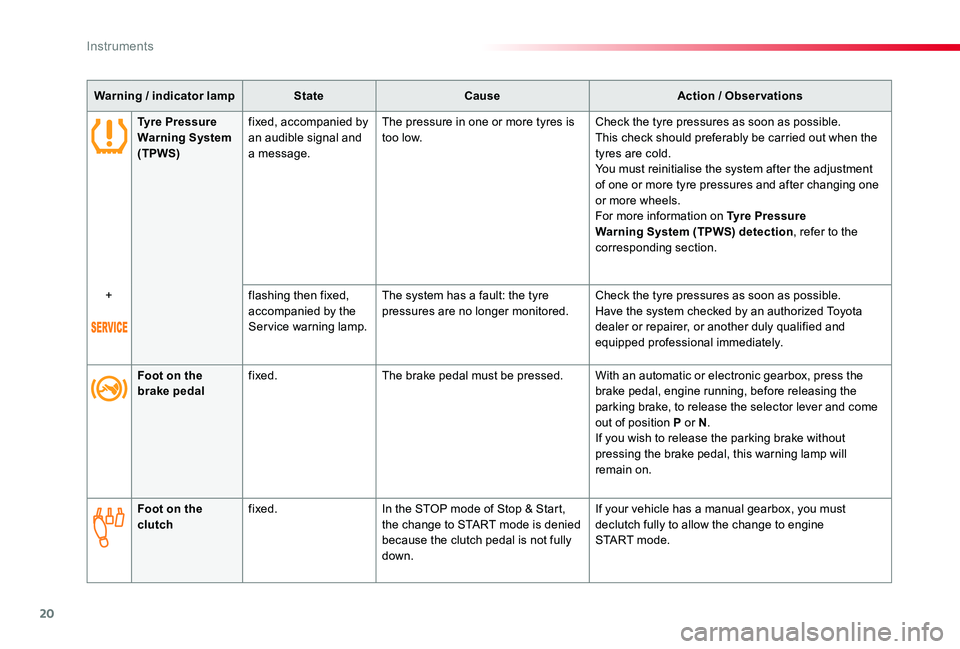
20
Warning / indicator lampStateCauseAction / Observations
Foot on the brake pedalfixed.The brake pedal must be pressed.With an automatic or electronic gearbox, press the brake pedal, engine running, before releasing the parking brake, to release the selector lever and come out of position P or N.If you wish to release the parking brake without pressing the brake pedal, this warning lamp will remain on.
Foot on the clutchfixed.In the STOP mode of Stop & Start, the change to START mode is denied because the clutch pedal is not fully down.
If your vehicle has a manual gearbox, you must declutch fully to allow the change to engine S TA R T m o d e .
Tyre Pressure Warning System (TPWS)
fixed, accompanied by an audible signal and a message.
The pressure in one or more tyres is too low.Check the tyre pressures as soon as possible.This check should preferably be carried out when the tyres are cold.You must reinitialise the system after the adjustment of one or more tyre pressures and after changing one or more wheels.For more information on Tyre Pressure Warning System (TPWS) detection, refer to the corresponding section.
+flashing then fixed, accompanied by the Ser vice warning lamp.
The system has a fault: the tyre pressures are no longer monitored.Check the tyre pressures as soon as possible.Have the system checked by an authorized Toyota dealer or repairer, or another duly qualified and equipped professional immediately.
Instruments